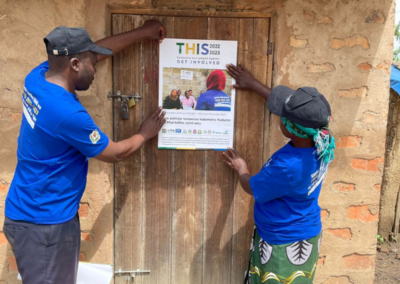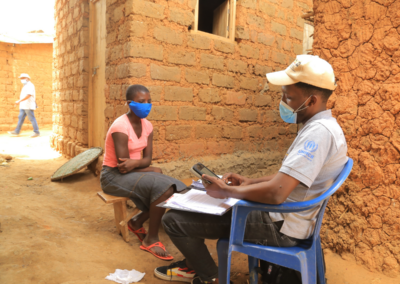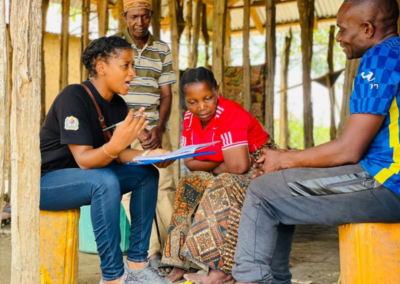Preliminary results from the PHIA Project are now available for Zimbabwe, Malawi, and Zambia, and the news is excellent. The new data show exceptional progress against the HIV epidemic: rates of new infection are down, the number of people living with HIV is stable, and over half of all people living with HIV are on antiretroviral treatment and virally suppressed.
“The effects of HIV have been far-reaching. But these outcomes affirm that global, country and U.S.-supported HIV efforts have been successful to date, and that strong progress is being made across the entire HIV continuum of care,” said Ambassador Deborah Birx, U.S. Global AIDS Coordinator.
A five-year, multi-country initiative funded by the U.S. President’s Emergency Plan for AIDS Relief (PEPFAR) through U.S. Centers for Disease Control and Prevention (CDC), and led by ICAP at Columbia University, the PHIA surveys are implemented in collaboration with CDC and the Ministry of Health and other partners in each country. The Project deploys nationally representative household surveys to collect information related to HIV and offer in-home HIV counseling and testing by trained survey staff, with immediate return of results. It also conducts laboratory tests to characterize the HIV epidemic in adults and children and to measure reach and access to prevention, care and treatment services in each country.
The PHIA surveys are also measuring progress toward the UNAIDS 90-90-90 targets: that by 2020, 90 percent of all people living with HIV will know their HIV status, 90 percent of all people diagnosed with HIV will receive treatment, and 90 percent of all people on treatment achieve viral load suppression. This would translate to 73 percent of all HIV-positive people being virally suppressed.
“The Population-based HIV Impact Assessments are a powerful new tool in that they paint the clearest picture to date of the HIV epidemic in several sub-Saharan countries. New findings from Malawi, Zambia, and Zimbabwe validate what we have only been able to previously predict in models – that our global efforts are having a measurable impact in countries with some of the most severe HIV epidemics,” said Dr. Shannon Hader, director of the CDC Division of Global HIV and Tuberculosis.
PHIA and HIV Incidence
PHIA is the first effort to measure the national rate of new HIV infections, or HIV incidence, in the three countries. “The survey was designed to identify the rate of new infections at the national level, as well as to estimate the number of people living with HIV,” said Dr. Jessica Justman, PHIA principal investigator and senior technical director at ICAP. “This information is critically important to determining future resource needs.”
Conducted between October 2015 and August 2016, the first three surveys found that HIV incidence is lower than previously estimated and well below 1 percent in each country. The PHIA data estimate HIV incidence
- In Zimbabwe as 0.45 percent (ages 15 to 64)
- In Malawi as 0.37 percent (ages 15 to 64)
- In Zambia as 0.66 percent (ages 15 to 59)
Compared to the 2003 incidence estimates between 1.3 and 1.5 percent per year for the same three countries, the current rate of new HIV infections has been cut in half during the past 13 years, when effective HIV treatment became available in sub-Saharan Africa, largely through support from PEPFAR.
PHIA and HIV Prevalence
HIV prevalence, or the percentage of people living with HIV, was measured for adults and children, and is similar to 2010 estimates. In addition to validating what has only been predicted previously in models, the surveys also provide new information, including the first measurements of pediatric HIV prevalence in Malawi and Zambia.
- In Zimbabwe, prevalence among adults ages 15 to 64 is 14.6 percent, and is 1.6 percent among children ages 0 to 14.
- In Malawi, prevalence among adults ages 15 to 64 is 10.6 percent, and is 1.6 percent among children ages 0 to 14.
- In Zambia, prevalence among adults ages 15 to 59 is 12.3 percent, and is 1.3 percent among children ages 0 to 14.
These three countries continue to bear a substantial HIV burden, however, with prevalence stabilizing, the PHIA survey results suggest that people living with HIV are living longer thanks to effective and accessible treatment.
PHIA and Viral Load Suppression
The survey also conducted viral load testing for HIV-positive participants, which measures the number of HIV particles in a milliliter of blood to assess the effectiveness of antiretroviral therapy (ART). Viral load suppression (VLS) is a measure of well-controlled HIV infection. Among HIV-positive adults in the first three PHIA countries, prevalence of VLS was:
- 60.4 percent for those ages 15 to 64 in Zimbabwe
- 67.6 percent among those ages 15 to 64 in Malawi
- 59.8 percent among those ages 15 to 59 in Zambia
“It is heartening to see the impressive viral suppression noted in the three countries among those on treatment,” said Dr. Wafaa El-Sadr, director of ICAP. “ Viral suppression is critical for the well-being of people living with HIV and for preventing HIV transmission to others.”
PHIA and 90-90-90
Preliminary PHIA data show that Zimbabwe, Malawi, and Zambia have made great strides in responding to their HIV epidemics. While increases in testing are needed to ensure that all people living with HIV know their status, the PHIA results show that Zimbabwe, Malawi, and Zambia are close to achieving the global targets for, treatment, and VLS.
- 74.2 percent of PLHIV ages 15 to 64 in Zimbabwe report knowing their status, 86.8 percent of those individuals self-report being on ART, and 86.5 percent of that group are virally suppressed
- 72.7 percent of PLHIV ages 15 to 64 in Malawi report knowing their status, 88.6 percent of those individuals self-report being on ART, and 90.8 percent of that group are virally suppressed
- 67.3 percent of PLHIV ages 15 to 59 in Zambia report knowing their status, 85.4 percent of those individuals self-report being on ART, and 89.2 percent of that group are virally suppressed
“These data suggest that, in the areas surveyed, we are making encouraging progress towards global targets for people on HIV treatment and virally suppressed. And although we’ve made great strides, these findings indicate we still need to do more to help ensure people living with HIV are reached with life-saving services,” said Dr. Hader of the CDC.
Looking Forward
The PHIA data offer critical evidence to inform global and national HIV programs and investments in order for progress to be sustained and built upon. However, achieving this will require continued expansion of HIV treatment programs and increased testing for all people, especially men and young women.
“Importantly, the PHIA surveys clearly point to what still needs to be done, who we need to reach, and where we must focus our efforts, in order to build on these achievements,” Ambassador Birx added. “The findings will guide an effective response to the epidemic.”










